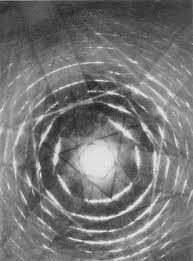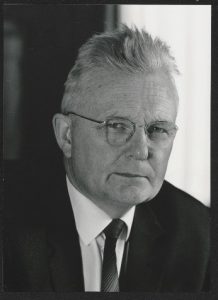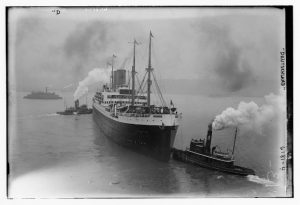Physicist Dr Alex Hubert, a Kent graduate, writes a personal account of the troubling history that lies behind his field of expertise.
A weary PhD student approaching the end of writing my thesis, I needed to look up the original paper [1] of the convergent beam electron diffraction (or CBED) technique [2]. Before I had the chance to read the usually mundane details within any such scientific publication, something immediately caught my eye. The number of citations. Only 136. I quickly looked up a recent review paper [3] (published in 1991) listing all of the citations where CBED had been used. Over 950. The number of citations for the original paper seemed very low for such an extensively used technique.
I looked at the authors, year and location. Two German sounding names, published in a German journal in 1939, from Danzig (now Gdansk) Poland. Alarm bells start to ring inside my head. Looking for any sort of distraction from my thesis, I decide to do some digging. I stumble across the German Wikipedia page [4] for Walther Kossel. A translated sentence stands out, “In November 1933 [Walther Kossel] signed the professors’ confession at the German universities and colleges to Adolf Hitler” [5,6]
The alarm bells were now deafening. As a young physicist I couldn’t help but wonder: was the technique my research is based on invented by Nazis? This question needed answering, I was now gripped by the engrossing hand of history. My thesis writing had to wait for a detour into the lives of Walther Kossel and Gottfried Möllenstedt.
Kossel was born in 1888 as the son of Albrecht Kossel [7] (a physician who won the Nobel prize in 1910 [8]) and Louise Holtzmann (daughter of Indologist Adolf Holtzmann [9]) in Berlin. Given his academic roots it was perhaps not surprising to learn he obtained his PhD in physics from the University of Heidelberg in 1911. It is here where we discover the first hint of Nazi influence – which may have lead to his signature on the Professors confession to Hitler. His thesis advisor Philipp Lenard [10], while a Nobel prize winning physicist, was famously known for his anti-Semitic views. Though, they seemed to have publicly surfaced [11] after Kossel left Heidelberg. Whether Kossel was influenced by Lenard is unknown. One is simply left to wonder if their conversations ever strayed from their work.
Kossel assisted many of Germany’s top physicists in the 1910’s and 20’s, including a close working relationship with Arnold Sommerfeld [12]. He made many contributions to atomic physics [13] during this period, before he took up a professorship at the University of Danzig in 1932.
He did so during extremely turbulent times in the free city. While Nazi occupation of Poland did not occur until 1939, Nazi influence in Poland was prevalent well before that year and especially in Danzig. Hitler saw the annexation of Danzig from Germany in 1920 as only temporary. He continually called for Danzig to be reunited with Germany [14] throughout the 1930’s. By 1936 Nazi party members held the majority in the city’s Senate [15,16]. This influence spread to the university too. Slowly but surely, academics of Jewish origin (or those known for their anti-Nazi views) were either dismissed or forced to retire. This included Albert Carsten [17], the architect behind the very first buildings of the university [18,19]. By 1936, only 38 full professors were left in the entire establishment – which included Kossel.
German-Polish tensions began to rise. A National Socialist society (Nazi society) was formed to replace all other societies (of which all students were obliged to join). The physicist Bormann [20], at this point an assistant to Kossel, was dismissed from the university for his refusal to join. Incidents between the two populations were increasing in severity. It seems a demonstration by one side would be met with a more severe response by the other. These escalations reached their peak in February 1939 where, according to the History of Gdansk university page [21], Nazi fighting squads forced Polish students out of the university. Most never returned. Very few academics seem to have spoken out during the slow takeover of the university by Nazi ideology. The ones who did, like Professors Sommer [22,23] and Krischen [24,25] were subsequently expelled.
It was under this backdrop of increasingly Nazi rule, where a young Möllenstedt was asked by Kossel to build a microscope able to produce the first CBED patterns for his PhD (he describes how he did so in a special article published in 1989 [26]). The paper showcasing the first CBED patterns was published in Annalen der Physik in July 1939, a mere 2 months before the occupation of Poland by Hitler (Danzig was one of the first locations to be attacked [27]) and the start of WWII.
With the city of Danzig now under Nazi rule, it wasn’t long until the university fully reflected Nazi policies (e.g. For entrance into the university students had to provide certificates of Aryan origin). By 1941 it seems there were no Polish students remaining at the university.
The work of Kossel and Möllenstedt continued irrespective of the war, based on the continued published works on CBED (e.g. [28]). It does not seem either contributed to the German war effort. Kossel appears to have been offered positions in Berlin and Strasburg, but he turned both down. From the limited evidence available it looks as if they were trying to stay out of the war. The war however, was about to come to them.
At the beginning of 1945 the Soviet troops were closing in on Danzig. Due to delays by Nazi officials in organising evacuation, the red army cut off escape to Germany by land. The only possible way out for the remaining citizens, including Möllenstedt and Kossel, was by sea. Fear was rife among the remaining German citizens due to stories of rape and pillaging by Soviet soldiers on other towns and cities. Danzig university was at this point more a hospital than a place of study. Courses were cancelled, research halted. The most important equipment, books and papers were loaded on to the escape ship SS Deutschland [29]. Staff and their families either went with the equipment on the SS Deutschland or via the Wilhelm Gustloff [30]. Both ships were heading to Kiel in Germany. Sadly, those who went via the Gustloff became part of the worst maritime disaster in history [31].
Built only to accommodate 1900 people, upwards of 10,000 people desperately packed onto the ship. The temperature outside was viscously cold, minus 18 degrees, so cold the life boats had frozen to the deck. Two of the ships accompanying the Gustloff had technical troubles and returned to Danzig, leaving only one torpedo boat. When a Soviet submarine encountered the Gustloff on the eve of January 30th, it was a sitting duck. Over 9000 people died.
Fortunately for Kossel and Möllenstedt, they decided to take the SS Deustchland. It was Möllenstedt who seemed to shoulder the responsibility over his and Kossel’s families, leaving most of their possessions behind. They became part of the east-Prussia evacuation [32] (or operation Hannibal) where over a period of 15 weeks, approximately 1.2 million German citizens and soldiers were evacuated to Germany or German occupied Denmark. Three times as many as Dunkirk. The SS Deutschland alone ferried over 70,000 people before it was bombed and sunken.
After their escape from Danzig into Germany, the two physicists eventually continued their research. Kossel remained in Germany for the rest of his life. Möllenstedt stayed in Germany for a while before moving to Japan.
It seems the story of CBED, of science under Nazi rule, of Kossel and Möllenstedt, is at best a lesson of inaction. It is near impossible to paint a picture where either of them would be unaware of the chaos ensuing around them. Of the near constant demonstrations against Jewish and Polish citizens during the 1930’s [33]. Of the removal of thousands of Jewish people from the community to the concentration camp in Stutloff, a mere 22 miles away (and subsequently the last to be liberated by the Allies). The once full university common room, lying empty. Even if somehow these events were to pass both’s attention the loss of their research assistant Bormann dare not.
I have only found hints of either Kossel or Möllenstedt’s political alignments. Which has left me full of questions that will most likely never be answered. Did Kossel sign the declaration to Hitler out of fear of losing his job, or for Nazi sympathies? What would have happened if Kossel and Möllenstedt spoke out? Would CBED have been invented by someone else? Did they ever share their ideologies with each other?
Kossel remained hidden from view. I have scarcely found anything relating to his character. This has not been the same for Möllenstedt. From my time reading about his life, he seemed like a likeable, compassionate and larger than life individual [34]. His labs seemed like an exciting place to be as a young scientist.
Therefore, it is one of the last hints Möllenstedt gave to the world which made me the most disappointed about his story. In the article he published in 1989: “My early work on convergent‐beam electron diffraction” [26], he mentions the war only once. He writes: “A detailed examination of the dynamical theory at high voltages, however, had to be postponed for later years or even decades because the events of the second world war set an end to the projects at Danzig”. Intended or not, this sentence gave me the impression he saw the war as getting in the way of his work. No mention of lost colleagues, of the chaos that gripped the city. Yet he did have space to mention his athletic career. At best it looks as if cognitive dissonance had taken a firm hold on Möllenstedt’s mind. Not only did he not have the bravery to speak out then, he didn’t 50 years later.
Alex Hubert
About the author:
I graduated from the University of Kent with an MPhys in 2014. I then decided to take on the challenge of a physics PhD at Warwick, which I successfully completed in September 2019. Currently, I am writing a series articles on mental health and wellbeing within the academic community and in general.
W: www.alexhubert.co.uk E: ajmh@alexhubert.co.uk
Footnotes/Bibliography:
[1] Kossel, W. and Möllenstedt, G., 1939. Elektroneninterferenzen im konvergenten Bündel. Annalen der Physik, 428(2), pp.113-140.
[2] Elsevier, 2019. Convergent Beam Electron Diffraction. Elsevier, viewed 31 Oct. 2019, < https://www.sciencedirect.com/topics/chemistry/convergent-beam-electron-diffraction>
[3] Sung, C. and Williams, D.B., 1991. Principles and applications of convergent beam electron diffraction: A bibliography (1938‐1990). Journal of electron microscopy technique, 17(1), pp.95-118.
[4] Wikipedia, 2019. Walther Kossel (translated). Wikipedia, viewed 31 Oct. 2019, <https://de.wikipedia.org/wiki/Walther_Kossel>
[5] Wikipedia, 2019. Confession of German professors to Adolf Hitler (translated). Wikipedia, viewed 31 Oct. 2019, <https://de.wikipedia.org/wiki/Bekenntnis_der_deutschen_Professoren_zu_Adolf_Hitler>
[6] Internet Archive, 2009. Commitment of professors at the universities and colleges to Adolf Hitler and the National Socialist state (translated). Internet Archive, viewed 31 Oct. 2019, <https://www.archive.org/stream/bekenntnisderpro00natiuoft#page/132/mode/1up>
[7] Wikipedia, 2019. Albrecht Kossel (translated). Wikipedia, viewed 31 Oct. 2019, <https://de.wikipedia.org/wiki/Albrecht_Kossel>
[8] Nobel Media, 2019. The Nobel Prize in Physiology or Medicine 1910. Nobel Media, viewed 31 Oct. 2019, <https://www.nobelprize.org/prizes/medicine/1910/summary/>
[9] Wikipedia, 2019. Adolf Holtzmann (translated). Wikipedia, viewed 31 Oct. 2019, <https://de.wikipedia.org/wiki/Adolf_Holtzmann>
[10] Wikipedia, 2019. Philipp Lenard (translated). Wikipedia, viewed 31 Oct. 2019, <https://en.wikipedia.org/wiki/Philipp_Lenard>
[11] Encyclopedia.com, 2019. Philipp Lenard. Encyclopedia.com, viewed 31 Oct. 2019, <https://www.encyclopedia.com/people/history/historians-miscellaneous-biographies/philipp-lenard>
[12] Wikipedia, 2019. Arnold Sommerfeld. Wikipedia, viewed 31 Oct 2019, <https://en.wikipedia.org/wiki/Arnold_Sommerfeld>
[13] Encyclopedia.com, 2019. Walther Kossel. Encyclopedia.com, viewed 31 Oct 2019, <https://www.encyclopedia.com/science/dictionaries-thesauruses-pictures-and-press-releases/kossel-walther-ludwig-julius-paschen-heinrich>
[14] Michael Fry, 2014. #tbt: Danzig and the Beginnings of World War II. National Geographic, viewed 31 Oct. 2019, <https://blog.education.nationalgeographic.org/2014/08/28/tbt-danzig-and-the-beginnings-of-world-war-ii/>
[15] Wikipedia, 2019. Free City of Danzig. Wikipedia, viewed 31 October 2019, <https://en.wikipedia.org/wiki/Free_City_of_Danzig>
[16] Levine, H.S., 1973. Hitler’s free city: a history of the Nazi Party in Danzig, 1925-39. Chicago and London: University of Chicago Press.
[17] Wikipedia, 2019. Albert Carsten (translated). Wikipedia, viewed 5 November 2019, < https://pl.wikipedia.org/wiki/Albert_Carsten>
[18] Waldemar A., 1998. The Silent Message of Architectural Decoration. Albert Carsten and the early 20th century buildings of the Gdansk university of technology, Poland. 6th Conference of the International Society for the Study of European Ideas, viewed 5 November 2019, < https://homepage.univie.ac.at/martin.potschka/papersISSEI1998/Affelt2.htm>
[19] Faculty of architecture, 2017. History of the Faculty. Gdansk university of technology, viewed 5 November 2019, < https://arch.pg.edu.pl/history-of-the-faculty>
[20] Wikipedia, 2018. Gerhard Borrmann. Wikipedia, viewed 5 November 2019, < https://en.wikipedia.org/wiki/Gerhard_Borrmann>
[21] Januszajtis, A. 2012. The history of the Technical University of Gdańsk up to 1945. Gdansk university of technology, viewed 5 November 2019, < http://www.pg.gda.pl/~mjasina/pehgo2000/hist2en.html>
[22] Wikipedia, 2019. Julius Sommer. Wikipedia, viewed 16 November, < https://de.wikipedia.org/wiki/Julius_Sommer>
[23] Gdansk University of Technology, 2017. Professor Julius Sommer (mathematics). Gdansk University of Technology, viewed 16 November 2019, < https://pg.edu.pl/uczelnia/rektorzy/prof-julius-sommer>
[24] Wikipedia, 2019. Fritz Krischen. Wikipedia, viewed 16 November, <https://de.wikipedia.org/wiki/Fritz_Krischen>
[25] Gdansk University of Technology, 2017. Professor Fritz Krischen (history of construction and art history). Gdansk University of Technology, viewed 16 November 2019, <https://pg.edu.pl/uczelnia/rektorzy/prof-fritz-krischen>
[26] Möllenstedt, G., 1989. My early work on convergent‐beam electron diffraction. physica status solidi (a), 116(1), pp.13-22.
[27] Wikipedia, 2019. Battle of Westerplatte. Wikipedia, viewed 5 November 2019, < https://en.wikipedia.org/wiki/Battle_of_Westerplatte>
[28] Kossel, W., Ackermann, I. and Möllenstedt, G., 1943. Symmetrically excited electron interferences. Journal of Physics, 120 (7-10), pp.553-560.
[29] Wikipedia, 2019. SS Deutschland. Wikipedia, viewed 5 November 2019, < https://en.wikipedia.org/wiki/SS_Deutschland_(1923)>
[30] Wikipedia, 2019. MV Wilhelm Gustloff. Wikipedia, viewed 5 November 2019, < https://en.wikipedia.org/wiki/MV_Wilhelm_Gustloff>
[31] Begley, S., 2016. The forgotten maritime tragedy that was 6 times deadlier than the Titanic. Time magazine, viewed 5 November 2019, <https://time.com/4198914/wilhelm-gustloff-salt-to-the-sea/>
[32] Wikipedia, 2019. Evacuation of east Prussia. Wikipedia, viewed 5 November 2019, < https://en.wikipedia.org/wiki/Evacuation_of_East_Prussia>
[33] Shindler, C., 2019. Danzig: The city where hell began and ended. The JC, viewed 5 November 2019, < https://www.thejc.com/news/news-features/danzig-the-city-where-hell-began-and-ended-1.488006>
[34] Tonomura, A., 1998. Prof Dr Gottfried MÖLLENSTEDT (1913–1997). Microscopy, 47(5), pp.363-364.





Recent Comments